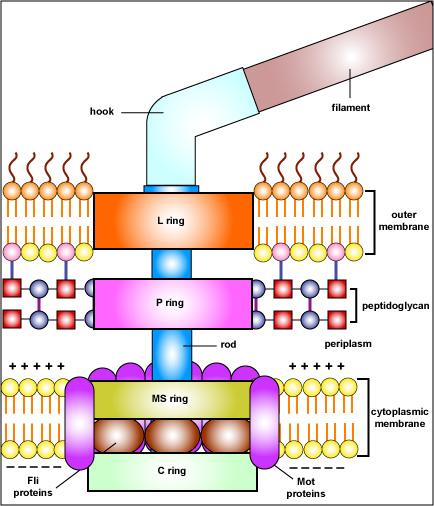
Flagellum motor: Energy for rotation comes from proton motive force. Protons moving through the Mot proteins drives rotation. The Fli proteins act as the motor switch to trigger either clockwise or counterclockwise rotation of the flagellum and to possibly disengage the rod in order to stop motility.
Sadaputa discussing with Prabhupada the irreducible complexity of a flagellum motor, July 3, 1976, Washington, D.C.: ..When they look at it under a microscope, they can see that this bacterium has a reversible motor built into it, and this motor spins a spiral flagellum, and by spinning it it propels the bacteria through the water, just like a submarine. So this very sophisticated motor is built into the wall of the bacterium. So that shows the kind of structures for which designs would have to be there. Actually, the scientific explanation, the way that they explain how this comes about, is completely impossible, because they would say that either by chance it came about all at once—and the chances are way too small, so that would never happen—or else it would have to come by small stages somehow. But what would be a small stage in the formation of a workable motor? Full Conversation
New Discovery: Flagellum Replaces Parts on the Fly
National Academy of Sciences, June 11, 2010: ..The flagellar motor was the first biological rotary device discovered. A biological nanomachinery on the molecular scale which masters maintenance during operation. A functional operation that involves dynamic swapping of parts while a rotor is spinning at more than 60,000 rpm! The bacterium doesn’t need to go into a drydock; its repair squad can fix parts on the fly. Scientists comment: We are just beginning to understand the dynamics of its individual components.
1. Delalez et al, “Signal-dependent turnover of the bacterial flagellar switch protein FliM,” Proceedings of the National Academy of Sciences, Published online before print May 24, 2010, doi: 10.1073/pnas.1000284107.
2. Michael D. Manson, “Dynamic motors for bacterial flagella,” Commentary, Proceedings of the National Academy of Sciences, print June 11, 2010, doi: 10.1073/pnas.1006365107. 







Speak Your Mind